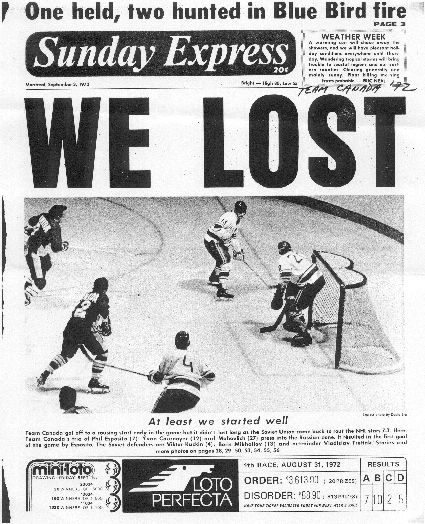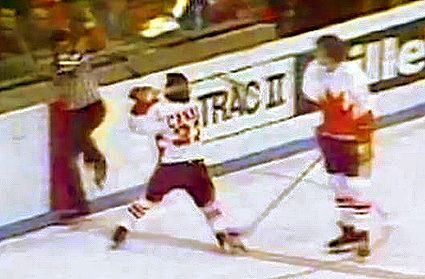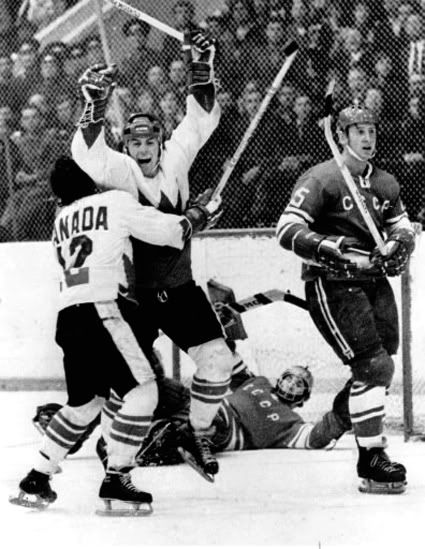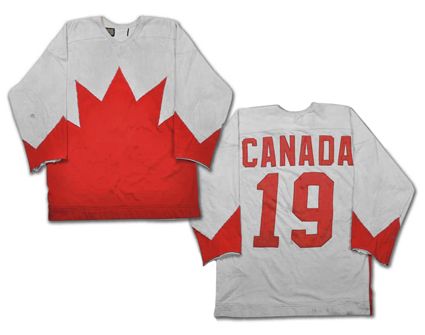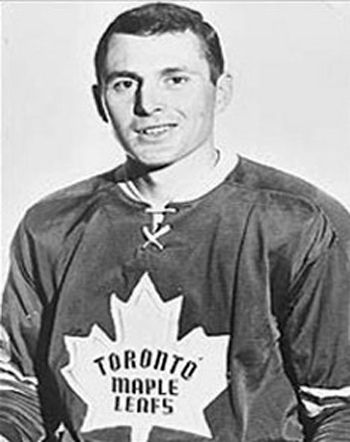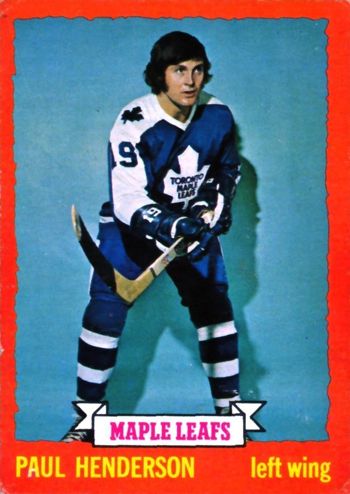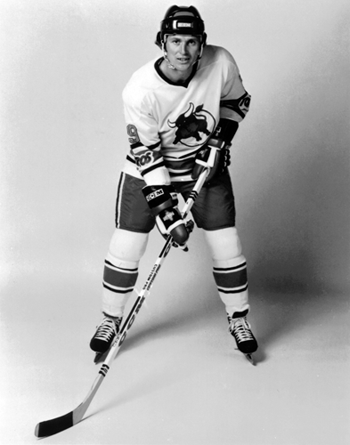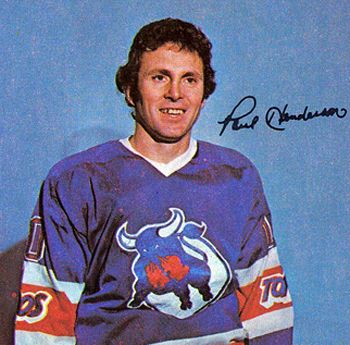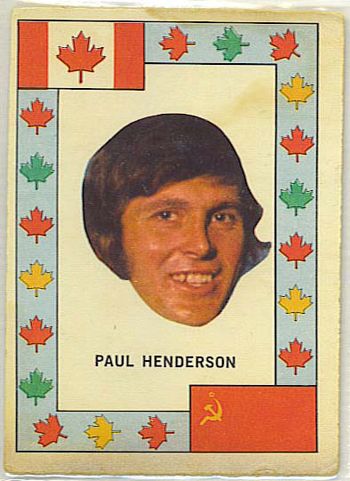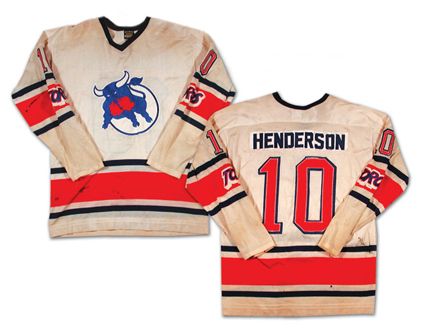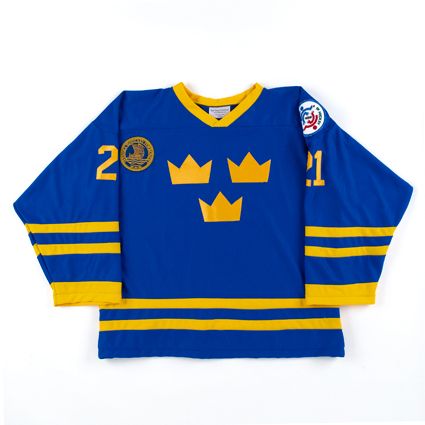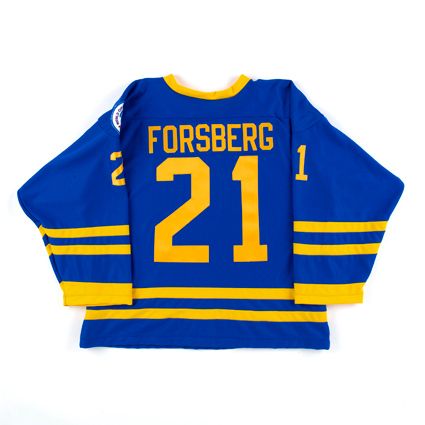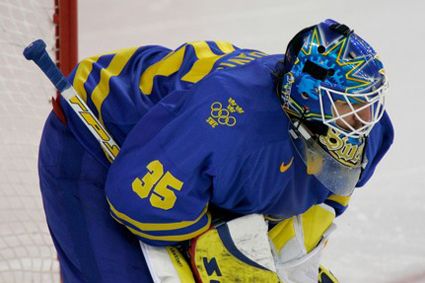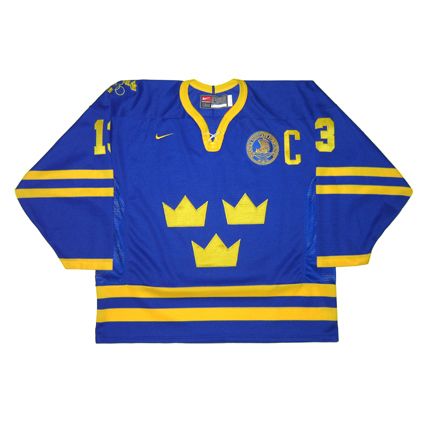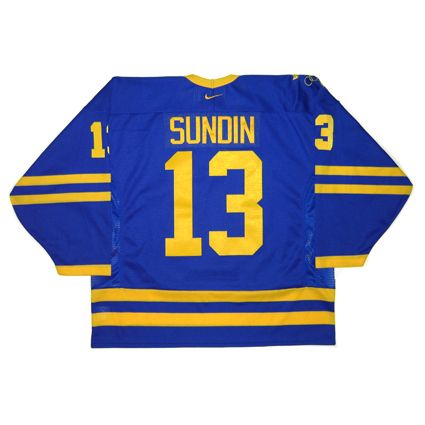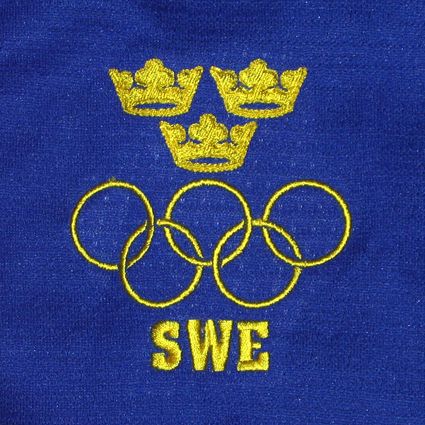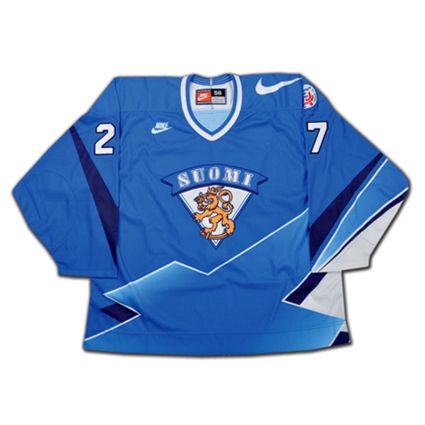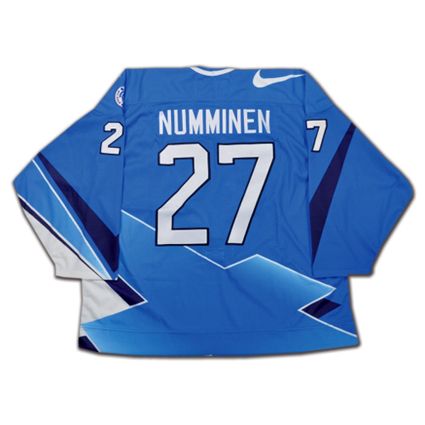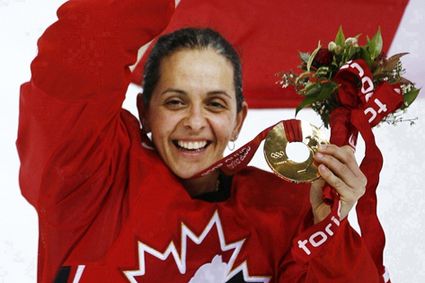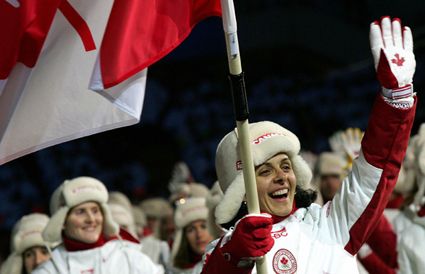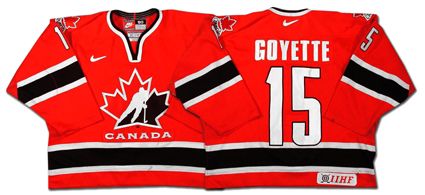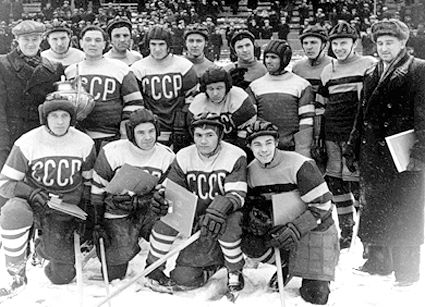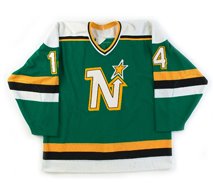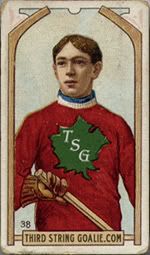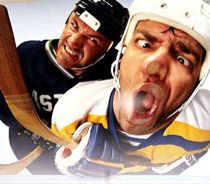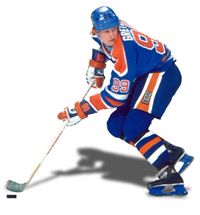Today is the induction ceremony for the
2013 IIHF Hall of Fame class, and it's a remarkable collection of talent with a long list of accomplishments.
Peter Forsberg's international career began in fine style at the 1991 European Junior Championships where he averaged just under 3 points per game with 5 goals and 12 assists for 17 points in 6 games to lead the tournament in scoring.
1992 saw him earn his first medal with a silver at the 1992 World Juniors (11 points in 7 games) before making his senior level debut later that spring at the World Championships where he contributed 4 goals and 6 points in 8 games to earn his first gold medal.
He repeated the double of playing in both the World Juniors and the World Championships in 1993, earning a silver medal on both occasions. In just 7 games of the World Juniors, Forsberg scored a remarkable 7 goals and 31 points to lead the tournament in scoring by a full 7 points, which included setting a single game record with 10 points in a dominating win over Japan.
Forsberg made his Olympic debut in 1994 in Lillehammer, Norway, where his gold medal winning goal in the shootout over Canada earned him immortality when it was commemorated on a Swedish postage stamp. He totaled 8 points in 8 games for the tournament.
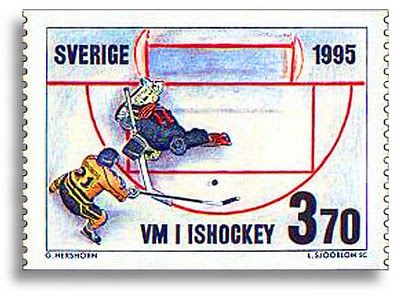 The Swedish postage stamp commemorating
Forsberg's goal at the 1994 Olympics
The Swedish postage stamp commemorating
Forsberg's goal at the 1994 Olympics
When Forsberg won the Stanley Cup with the Colorado Avalanche in 1996, he became only the sixth member of the Triple Gold Club in recognition of his gold medals at both the World Championships and the Olympics as well as winning a Stanley Cup.
The first bronze medal of his career arrived at the 1996 World Cup of Hockey and his second Olympic opportunity came in 1998 when the stars of the NHL were able to participate for the first time in Nagano, Japan.
1998 saw Forsberg return to the World Championships for the first time in five years where he was again a key part of Sweden claiming the gold medal thanks to his 11 points in 7 games.
Two more silver medals followed in 2003 and 2004 at the World Championships as well as a second appearance at the World Cup of Hockey in the fall of 2004.
Forsberg would win his second Olympic gold medal at the 2006 Games in Torino, Italy where he averaged a point per game with 6 assists in 6 games.
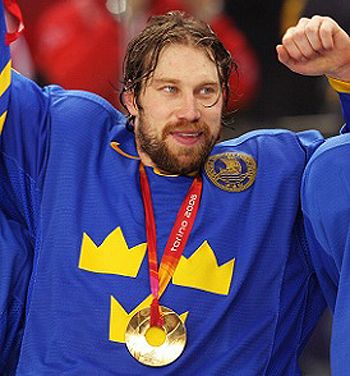 Forsberg's second Olympic gold arrived in 2006
Forsberg's second Olympic gold arrived in 2006
His international career would conclude in 2010 with his fourth Olympic participation of his career.
In total, Forsberg would score 35 goals and 81 assists for 116 points in 83 games while winning one bronze, five silver and four gold medals, two at the World Championships and two at the Olympics.
Today's first featured jersey is a 1996 Sweden National Team Peter Forsberg jersey from the 1996 World Cup of Hockey. Sweden would win the European pool with a 3-0 record, defeating Finland, Germany and the Czech Republic, before losing 3-2 to Canada in two overtimes in the semi-finals.
This jersey features the large 4" diameter 1996 World Cup of Hockey patch worn by all the Bauer supplied teams in the tournament, which also included Canada and the Czech Republic. The remaining teams, the United States, Russia, Slovakia, Finland and Germany all wore Nike jerseys which sported the same patch, only in a 3" size.
Fellow Swede
Mats Sundin participated at the 1989 and 1990 European Junior Championships, the 1990 World Juniors before moving up to the senior level in 1991 with a gold medal at the World Championships before then being a member of the 1991 Canada Cup team.
His second gold medal came in the 1992 World Championships and was followed by a bronze at the 1994 Worlds where he set a personal best with 14 points in 8 games. He participated at the 1996 World Cup of Hockey before making his Olympic debut at the 1998 Games in Japan.
His third gold medal came at the 1998 World Championships following another strong performance with 11 points in 10 games.
2001 would see a second bronze medal added to his collection at the 2001 World Championships before a second Olympics in 2002 at Salt Lake City. The first silver of Sundin's career came in 2003 at the World Championships which was followed by his second World Cup of Hockey in 2004.
Sundin's international career came to a conclusion in the finest manner possible when he captained Sweden to a gold medal at the 2006 Olympics in Italy while contributing 3 goals and 8 points in 8 games.
Sundin and Forsberg celebrating their gold medals in 2006
Sundin would score 47 goals and 100 points in 81 games during his international career, winning two bronze, one silver and four gold medals.
Today's second featured jersey is a 2006 Sweden National Team Mat Sundin jersey. 2006 was the year that Nike introduced the brand new Nike Swift jerseys, first seen at the World Junior Tournament on the USA and Canada. Each of the 12 participating countries in the 2006 Olympics wore the new Swift designs, except for Switzerland and the eventual gold medal winners Sweden, who were somehow able to overcome the truck-like weight and aerodynamics of the old style jerseys when compared to the new technologically advanced jerseys the rest of the field was outfitted with.
Two unique additions to the 2006 Swedish Olympic jerseys were an attempt to create a "lace up" collar style, which was simply a few slits cut into the existing yoke collar and threading a white elastic threat through it, which did not actually have to be tied, as it was a single continuous piece.
The second unique feature of the jerseys at the 2006 Olympics was the Swedish Olympic logo added to the right shoulders.
The Swedish Olympic logo added to their jerseys at the 2006 games
Given the opportunity, Sweden always opts for their traditional bright yellow jerseys with blue crowns, stripes, names and numbers, but for this contest they captured gold in their road blue sweaters.
Defenseman
Teppo Numminen of Finland's lengthy career began at the 1986 European Junior Championships before he joined the senior team at the 1987 World Championships and later the 1987 Canada Cup. Still eligible, Numminen then played in the 1988 World Junior Championships (scoring 5 goals and 7 points in 7 games on his way to a bronze medal) which was quickly followed by his Olympic debut at the 1988 Games in Calgary where he won a silver medal.
He would return to the international stage in 1991 at the World Championships followed later that year with his second Canada Cup tournament.
The 1996 World Championships began a series of appearances which included the 1996 World Cup of Hockey, the 1997 World Championships and the 1998 Olympics, earning a bronze medal.
Numminen would return to the Olympics in 2002 in Salt Lake City, skate for Finland at the 2004 World Cup of Hockey and close out his lengthy international career in 2006 at the Olympic Games in Italy where he was rewarded with a silver medal.
Today's third featured jersey is a
1996 Finland National Team Teppo Numminen jersey. This attractive "waving flag" style jersey was worn by Numminen at the 1996 World Cup of Hockey, and being a Nike jersey, had the smaller 3" size tournament logo patch on the upper left arm.
While
Paul Henderson's international career is not as lengthy as those of his fellow inductees, his performance during the final games of the 1972 Summit Series were quite memorable and concluded with one of hockey's most memorable goals, his late game winner against the Soviet Union in Game 8, an iconic moment in the history of international hockey. He had scored goals in Game 1 and Game 5, but was also knocked unconscious later in that same game. He returned later in Game 5 and scored the game winning goal in Game 6, a 3-2 win for Canada.
Canada won Game 7 4-3, with Henderson again scoring the game winning goal while being tripped at the time. Late in the final Game 8, Henderson came off the bench, but missed a pass and was tripped and fell behind the goal. He returned to his feet in time to receive a pass from Phil Esposito and fire a shot, which was blocked. The rebound came back to him, which he fired into the goal past Vladislav Tretiak with just 34 seconds to play to give him his third consecutive game winning goal and the series win, making him an instant hero in Canada.
"Henderson scores for Canada!"
Henderson left the NHL for the World Hockey Association in 1974, which made him eligible for the follow up 1974 Summit Series, his only other appearance for Team Canada.
Today's fourth featured jersey is a 1972 Team Canada Paul Henderson jersey as worn during the four 1972 Summit Series games in Moscow.
This jersey came up for public sale for the first time ever at auction in June of 2010 on ClassicAuctions.net.
The concern and publicity over the possible threat to "the most significant artifact in the history of the game of hockey" due to it falling into the the wrong hands and being cut to pieces for inclusion on trading cards eventually saw the jersey sell for a record shattering $1,275,707, far outstripping the reported $250,000 paid for a Wayne Gretzky game worn jersey and the $191,000 for a Bobby Orr rookie jersey and easily withstanding a later challenge from Mike Eruzione's 1980 United States "Miracle on Ice" jersey, which reached $657,250.
The winning bidder, Canadian real estate developer
Mitchell Goldhar, not only preserved the jersey from possible destruction, but returned it to Canada from where it had been located in the United States, but took the iconic Canadian sweater on a
tour of the country in an effort to
share it with the citizens of the nation where everyone remembers where they were when Henderson score his dramatic goal. One of the highlights of the jerseys return to Canada was having Henderson don the jersey once again.
Danielle Goyette of Canada played in three Olympics, winning silver in 1998 and gold medals in 2002 and 2006, and nine World Championships, winning gold eight times (1992, 1994, 1997, 1999, 2000, 2001, 2004 and 2007) and silver in 2005.
Goyette with her second Olympic gold in 2006
She averaged a point and a half per game and led all players in goals at the 1998 Olympics and was the scoring leader at the 1992 World Championships and the 2002 Olympics. Additionally, she was honored by being Canada's flag bearer at the 2006 Olympics in Italy.
Goyette was Canada's flag bearer in 2006
Today's fifth featured jersey is a
2002 Canada National Team Danielle Goyette jersey. This jersey was worn in the games leading up to the 2002 Olympics during which Goyette won her first Olympic gold medal.
Note the back numbers crossing into the waist stripes, an indication of the shorter length of the women's jerseys.
In addition to those players, builder
Jan-Ake Edvinsson, broadcaster
Gord Miller and the 1954 Soviet Union National Team will also be honored.
The 1954 Soviet Union National Team

